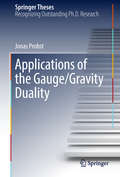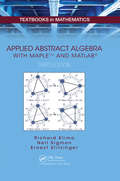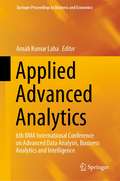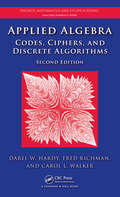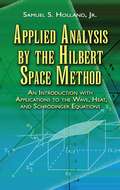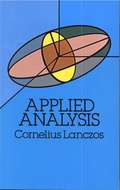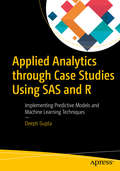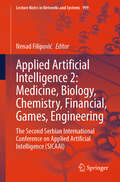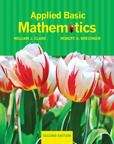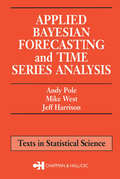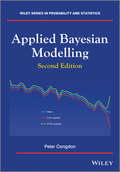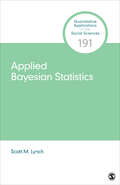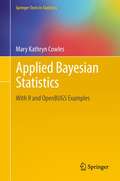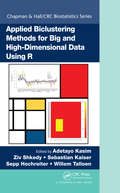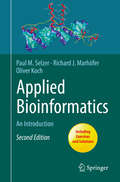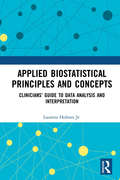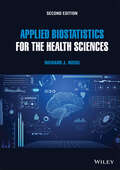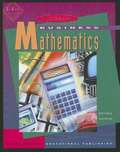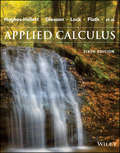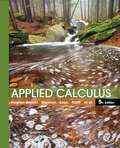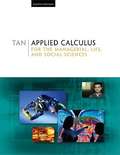- Table View
- List View
Applications of the Gauge/Gravity Duality (Springer Theses)
by Jonas ProbstMany open questions in Theoretical Physics pertain to strongly interacting quantum systems such as the quark-gluon plasma (QGP) produced in heavy-ion collisions or the strange-metal phase observed in many high-temperature superconductors. These systems are notoriously difficult to study using traditional methods such as perturbation theory, but the gauge/gravity duality offers a successful alternative approach, which maps strongly interacting quantum gauge theories to computationally tractable, classical gravity theories. This book begins with a pedagogical introduction to how the duality can be used to extract transport properties of quantum systems from their gravity dual. It then presents new results on hydrodynamic transport in strongly interacting quantum fluids, providing strong evidence that the Haack-Yarom identity between second-order transport coefficients holds for all fluids with a classical gravity dual and may be a universal feature of all strongly coupled quantum fluids such as the QGP. Newly derived Kubo formulae, expressing transport coefficients in terms of quantum correlators, hold independently of the duality. Lastly, the book discusses new results on magnetic impurities in strongly correlated metals, including the first dual gravity description of an inter-impurity coupling, crucial for the quantum criticality underlying the strange-metal phase.
Applied Abstract Algebra with MapleTM and MATLAB: A Maple And Matlab Approach
by Richard Klima Neil Sigmon Ernest StitzingerApplied Abstract Algebra with MapleTM and MATLAB provides an in-depth introduction to real-world abstract algebraic problems. This popular textbook covers a variety of topics including block designs, coding theory, cryptography, and counting techniques, including Polya's and Burnside's theorems. The book also includes a concise review of all prereq
Applied Advanced Analytics: 6th IIMA International Conference on Advanced Data Analysis, Business Analytics and Intelligence (Springer Proceedings in Business and Economics)
by Arnab Kumar LahaThis book covers several new areas in the growing field of analytics with some innovative applications in different business contexts, and consists of selected presentations at the 6th IIMA International Conference on Advanced Data Analysis, Business Analytics and Intelligence. The book is conceptually divided in seven parts. The first part gives expository briefs on some topics of current academic and practitioner interests, such as data streams, binary prediction and reliability shock models. In the second part, the contributions look at artificial intelligence applications with chapters related to explainable AI, personalized search and recommendation, and customer retention management. The third part deals with credit risk analytics, with chapters on optimization of credit limits and mitigation of agricultural lending risks. In its fourth part, the book explores analytics and data mining in the retail context. In the fifth part, the book presents some applications of analytics to operations management. This part has chapters related to improvement of furnace operations, forecasting food indices and analytics for improving student learning outcomes. The sixth part has contributions related to adaptive designs in clinical trials, stochastic comparisons of systems with heterogeneous components and stacking of models. The seventh and final part contains chapters related to finance and economics topics, such as role of infrastructure and taxation on economic growth of countries and connectedness of markets with heterogenous agents, The different themes ensure that the book would be of great value to practitioners, post-graduate students, research scholars and faculty teaching advanced business analytics courses.
Applied Algebra and Number Theory
by Gerhard Larcher Friedrich Pillichshammer Arne Winterhof Chaoping XingHarald Niederreiter's pioneering research in the field of applied algebra and number theory has led to important and substantial breakthroughs in many areas. This collection of survey articles has been authored by close colleagues and leading experts to mark the occasion of his 70th birthday. The book provides a modern overview of different research areas, covering uniform distribution and quasi-Monte Carlo methods as well as finite fields and their applications, in particular, cryptography and pseudorandom number generation. Many results are published here for the first time. The book serves as a useful starting point for graduate students new to these areas or as a refresher for researchers wanting to follow recent trends.
Applied Algebra: Codes, Ciphers and Discrete Algorithms, Second Edition (Discrete Mathematics and Its Applications)
by Darel W. Hardy Fred Richman Carol L. WalkerUsing mathematical tools from number theory and finite fields, Applied Algebra: Codes, Ciphers, and Discrete Algorithms, Second Edition presents practical methods for solving problems in data security and data integrity. It is designed for an applied algebra course for students who have had prior classes in abstract or linear algebra. While the content has been reworked and improved, this edition continues to cover many algorithms that arise in cryptography and error-control codes. New to the Second Edition Downloadable resources containing an interactive version of the book that is powered by Scientific Notebook®, a mathematical word processor and easy-to-use computer algebra system New appendix that reviews prerequisite topics in algebra and number theory Double the number of exercises Instead of a general study on finite groups, the book considers finite groups of permutations and develops just enough of the theory of finite fields to facilitate construction of the fields used for error-control codes and the Advanced Encryption Standard. It also deals with integers and polynomials. Explaining the mathematics as needed, this text thoroughly explores how mathematical techniques can be used to solve practical problems. About the AuthorsDarel W. Hardy is Professor Emeritus in the Department of Mathematics at Colorado State University. His research interests include applied algebra and semigroups.Fred Richman is a professor in the Department of Mathematical Sciences at Florida Atlantic University. His research interests include Abelian group theory and constructive mathematics.Carol L. Walker is Associate Dean Emeritus in the Department of Mathematical Sciences at New Mexico State University. Her research interests include Abelian group theory, applications of homological algebra and category theory, and the mathematics of fuzzy sets and fuzzy logic.
Applied Analysis by the Hilbert Space Method: An Introduction with Applications to the Wave, Heat, and Schrödinger Equations
by Samuel S. Holland Jr.Numerous worked examples and exercises highlight this unified treatment of the Hermitian operator theory in its Hilbert space setting. Its simple explanations of difficult subjects make it accessible to undergraduates as well as an ideal self-study guide.Featuring full discussions of first and second order linear differential equations, the text introduces the fundamentals of Hilbert space theory and Hermitian differential operators. It derives the eigenvalues and eigenfunctions of classical Hermitian differential operators, develops the general theory of orthogonal bases in Hilbert space, and offers a comprehensive account of Schrödinger's equations. In addition, it surveys the Fourier transform as a unitary operator and demonstrates the use of various differentiation and integration techniques.Samuel S. Holland, Jr. is a professor of mathematics at the University of Massachusetts, Amherst. He has kept this text accessible to undergraduates by omitting proofs of some theorems but maintaining the core ideas of crucially important results. Intuitively appealing to students in applied mathematics, physics, and engineering, this volume is also a fine reference for applied mathematicians, physicists, and theoretical engineers.
Applied Analysis: Prentice Hall Mathematics Series (Dover Books on Mathematics)
by Cornelius LanczosThis is a basic text for graduate and advanced undergraduate study in those areas of mathematical analysis that are of primary concern to the engineer and the physicist, most particularly analysis and design of finite processes that approximate the solution of an analytical problem. The work comprises seven chapters:Chapter I (Algebraic Equations) deals with the search for roots of algebraic equations encountered in vibration and flutter problems and in those of static and dynamic stability. Useful computing techniques are discussed, in particular the Bernoulli method and its ramifications.Chapter II (Matrices and Eigenvalue Problems) is devoted to a systematic development of the properties of matrices, especially in the context of industrial research.Chapter III (Large-Scale Linear Systems) discusses the "spectroscopic method" of finding the real eigenvalues of large matrices and the corresponding method of solving large-scale linear equations as well as an additional treatment of a perturbation problem and other topics.Chapter IV (Harmonic Analysis) deals primarily with the interpolation aspects of the Fourier series and its flexibility in representing empirically given equidistant data.Chapter V (Data Analysis) deals with the problem of reduction of data and of obtaining the first and even second derivatives of an empirically given function — constantly encountered in tracking problems in curve-fitting problems. Two methods of smoothing are discussed: smoothing in the small and smoothing in the large.Chapter VI (Quadrature Methods) surveys a variety of quadrature methods with particular emphasis on Gaussian quadrature and its use in solving boundary value problems and eignenvalue problems associated with ordinary differential equations.Chapter VII (Power Expansions) discusses the theory of orthogonal function systems, in particular the "Chebyshev polynomials."This unique work, perennially in demand, belongs in the library of every engineer, physicist, or scientist interested in the application of mathematical analysis to engineering, physical, and other practical problems.
Applied Analytics through Case Studies Using SAS and R: Implementing Predictive Models and Machine Learning Techniques
by Deepti GuptaExamine business problems and use a practical analytical approach to solve them by implementing predictive models and machine learning techniques using SAS and the R analytical language. This book is ideal for those who are well-versed in writing code and have a basic understanding of statistics, but have limited experience in implementing predictive models and machine learning techniques for analyzing real world data. The most challenging part of solving industrial business problems is the practical and hands-on knowledge of building and deploying advanced predictive models and machine learning algorithms. Applied Analytics through Case Studies Using SAS and R is your answer to solving these business problems by sharpening your analytical skills. What You'll Learn Understand analytics and basic data concepts Use an analytical approach to solve Industrial business problems Build predictive model with machine learning techniquesCreate and apply analytical strategiesWho This Book Is ForData scientists, developers, statisticians, engineers, and research students with a great theoretical understanding of data and statistics who would like to enhance their skills by getting practical exposure in data modeling.
Applied Artificial Intelligence 2: The Second Serbian International Conference on Applied Artificial Intelligence (SICAAI) (Lecture Notes in Networks and Systems #999)
by Nenad FilipovićThe book Applied Artificial Intelligence 2: Medicine, Biology, Chemistry, Financial, Games, Engineering is providing exceptional chapters of the state-of-the-art research knowledge and results on the innovative theories, methodology and applications of artificial intelligence and its sub-domain like deep learning, machine learning in different areas such as medicine, economy, education, law, smart city, government, industry etc. Innovative research ideas on how to solve problems using artificial intelligence, both in R&D and real-time applications are presented. Chapters describe the advanced prototypes, systems, methodologies, tools and techniques and general survey papers, which indicate future directions. These Chapters are extended papers from the Second Serbian International Conference on Applied Artificial Intelligence (SICAAI), which was held in Kragujevac, Serbia, on May 19-20, 2023
Applied Basic Mathematics
by William Clark Robert A. BrechnerWith an emphasis on real world applications, Applied Basic Mathematics, Second Edition, provides students with a new and refreshing perspective on basic math. Paired with a system of structured support, authors Clark and Brechner consistently asks student to relate, reinforce, and review as they learn. This text provides professors with a dynamic way of teaching the material and an approach that encourages students to dive into the math!
Applied Bayesian Forecasting and Time Series Analysis
by Andy Pole Mike West Jeff HarrisonPractical in its approach, Applied Bayesian Forecasting and Time Series Analysis provides the theories, methods, and tools necessary for forecasting and the analysis of time series. The authors unify the concepts, model forms, and modeling requirements within the framework of the dynamic linear mode (DLM). They include a complete theoretical development of the DLM and illustrate each step with analysis of time series data. Using real data sets the authors: Explore diverse aspects of time series, including how to identify, structure, explain observed behavior, model structures and behaviors, and interpret analyses to make informed forecasts Illustrate concepts such as component decomposition, fundamental model forms including trends and cycles, and practical modeling requirements for routine change and unusual events Conduct all analyses in the BATS computer programs, furnishing online that program and the more than 50 data sets used in the text The result is a clear presentation of the Bayesian paradigm: quantified subjective judgements derived from selected models applied to time series observations. Accessible to undergraduates, this unique volume also offers complete guidelines valuable to researchers, practitioners, and advanced students in statistics, operations research, and engineering.
Applied Bayesian Modelling
by Peter CongdonThis book provides an accessible approach to Bayesian computing and data analysis, with an emphasis on the interpretation of real data sets. Following in the tradition of the successful first edition, this book aims to make a wide range of statistical modeling applications accessible using tested code that can be readily adapted to the reader's own applications. The second edition has been thoroughly reworked and updated to take account of advances in the field. A new set of worked examples is included. The novel aspect of the first edition was the coverage of statistical modeling using WinBUGS and OPENBUGS. This feature continues in the new edition along with examples using R to broaden appeal and for completeness of coverage.
Applied Bayesian Statistics (Quantitative Applications in the Social Sciences)
by Scott M. LynchBayesian statistical analyses have become increasingly common over the last two decades. The rapid increase in computing power that facilitated their implementation coincided with major changes in the research interests of, and data availability for, social scientists. Specifically, the last two decades have seen an increase in the availability of panel data sets, other hierarchically structured data sets including spatially organized data, along with interests in life course processes and the influence of context on individual behavior and outcomes. The Bayesian approach to statistics is well-suited for these types of data and research questions. Applied Bayesian Statistics is an introduction to these methods that is geared toward social scientists. Author Scott M. Lynch makes the material accessible by emphasizing application more than theory, explaining the math in a step-by-step fashion, and demonstrating the Bayesian approach in analyses of U.S. political trends drawing on data from the General Social Survey.
Applied Bayesian Statistics (Quantitative Applications in the Social Sciences)
by Scott M. LynchBayesian statistical analyses have become increasingly common over the last two decades. The rapid increase in computing power that facilitated their implementation coincided with major changes in the research interests of, and data availability for, social scientists. Specifically, the last two decades have seen an increase in the availability of panel data sets, other hierarchically structured data sets including spatially organized data, along with interests in life course processes and the influence of context on individual behavior and outcomes. The Bayesian approach to statistics is well-suited for these types of data and research questions. Applied Bayesian Statistics is an introduction to these methods that is geared toward social scientists. Author Scott M. Lynch makes the material accessible by emphasizing application more than theory, explaining the math in a step-by-step fashion, and demonstrating the Bayesian approach in analyses of U.S. political trends drawing on data from the General Social Survey.
Applied Bayesian Statistics: With R and OpenBUGS Examples (Springer Texts in Statistics #98)
by Mary Kathryn CowlesThis book is based on over a dozen years teaching a Bayesian Statistics course. The material presented here has been used by students of different levels and disciplines, including advanced undergraduates studying Mathematics and Statistics and students in graduate programs in Statistics, Biostatistics, Engineering, Economics, Marketing, Pharmacy, and Psychology. The goal of the book is to impart the basics of designing and carrying out Bayesian analyses, and interpreting and communicating the results. In addition, readers will learn to use the predominant software for Bayesian model-fitting, R and OpenBUGS. The practical approach this book takes will help students of all levels to build understanding of the concepts and procedures required to answer real questions by performing Bayesian analysis of real data. Topics covered include comparing and contrasting Bayesian and classical methods, specifying hierarchical models, and assessing Markov chain Monte Carlo output. Kate Cowles taught Suzuki piano for many years before going to graduate school in Biostatistics. Her research areas are Bayesian and computational statistics, with application to environmental science. She is on the faculty of Statistics at The University of Iowa.
Applied Biclustering Methods for Big and High-Dimensional Data Using R (Chapman & Hall/CRC Biostatistics Series)
by Ziv Shkedy Sebastian Kaiser Adetayo Kasim Sepp Hochreiter Willem TalloenProven Methods for Big Data Analysis As big data has become standard in many application areas, challenges have arisen related to methodology and software development, including how to discover meaningful patterns in the vast amounts of data. Addressing these problems, Applied Biclustering Methods for Big and High-Dimensional Data Using R shows how to apply biclustering methods to find local patterns in a big data matrix.The book presents an overview of data analysis using biclustering methods from a practical point of view. Real case studies in drug discovery, genetics, marketing research, biology, toxicity, and sports illustrate the use of several biclustering methods. References to technical details of the methods are provided for readers who wish to investigate the full theoretical background. All the methods are accompanied with R examples that show how to conduct the analyses. The examples, software, and other materials are available on a supplementary website.
Applied Bioinformatics (2nd Edition): An Introduction
by Paul M. Selzer Oliver Koch Richard J. MarhöferThis book introduces readers to the basic principles of bioinformatics and the practical application and utilization of computational tools, without assuming any prior background in programming or informatics. <P><P>It provides a coherent overview of the complex field and focuses on the implementation of online tools, genome databases and software that can benefit scientists and students in the life sciences. Training tutorials with practical bioinformatics exercises and solutions facilitate the understanding and application of such tools and interpretation of results. In addition, a glossary explains terminology that is widely used in the field. This straightforward introduction to applied bioinformatics offers an essential resource for students, as well as scientists seeking to understand the basis of sequencing analysis, functional genomics and protein structure predictions.
Applied Biostatistical Principles and Concepts: Clinicians' Guide to Data Analysis and Interpretation
by Laurens Holmes, Jr.The past three decades have witnessed modern advances in statistical modeling and evidence discovery in biomedical, clinical, and population-based research. With these advances come the challenges in accurate model stipulation and application of models in scientific evidence discovery Applied Biostatistical Principles and Concepts provides practical knowledge using biological and biochemical specimen/samples in order to understand health and disease processes at cellular, clinical, and population levels. Concepts and techniques provided will help researchers design and conduct studies, then translate data from bench to clinics in attempt to improve the health of patients and populations. This book is suitable for both clinicians and health or biological sciences students. It presents the reality in statistical modelling of health research data in a concise manner that will address the issue of "big data" type I error tolerance and probability value, effect size and confidence interval for precision, effect measure modification and interaction as well as confounders, thus allowing for more valid inferences and yielding results that are more reliable, valid and accurate.
Applied Biostatistics for the Health Sciences
by Richard J. RossiAPPLIED BIOSTATISTICS FOR THE HEALTH SCIENCES APPLIED BIOSTATISTICS FOR THE HEALTH SCIENCES In this newly revised edition of Applied Biostatistics for the Health Sciences, accomplished statistician Dr. Richard Rossi delivers a robust and easy-to-understand exploration of statistics in the context of applied health science and biostatistics. The book covers sample design, logistic regression, experimental design, survival analysis, basic statistical computation, and many more topics with a strong focus on the correct use and interpretation of statistics. The author also explains how to assess the quality of observed data, how to collect quality data, and the use of confidence intervals in conjunction with hypothesis and significance tests. A thorough introduction to biostatistics, including explanations of fundamental concepts like populations, samples, statistics, biomedical studies, and data set examples A comprehensive exploration of population descriptions, including qualitative and quantitative variables, multivariate data, measures of dispersion, and probability Practical discussions of random sampling, summarizing random samples, and the measurement of the reliability of statistics In-depth examinations of confidence intervals, statistical hypothesis testing, simple and multiple linear regression, and experimental design Perfect for health science and biostatistics students and professors at the upper undergraduate and graduate levels, Applied Biostatistics for the Health Sciences is also a must-read reference for practitioners and professionals in the fields of pharmacy, biochemistry, nursing, health care informatics, and the applied health sciences.
Applied Business Mathematics
by Robert A. Schultheis Raymond M. KaczmarskiHelps students to assess what they've learned by providing excercises pertaining to what was learned in each chapter. Includes true/false, short answer, multiple choice, etc. questions.
Applied Business Mathematics (14th Edition)
by Robert A. Schultheis Raymond M. KaczmarskiThis classic, newly-revised book presents fundamental mathematics in the context of business and consumer applications to help put readers on the path to success. The all-new 1997 edition improves upon previous editions with a wealth of updated features. The material in Applied Business Mathematics will teach the student, the mathematical and critical thinking skills that will help him be a smart shopper, an informed citizen, and a valued employee.
Applied Calculus
by Deborah Hughes-Hallett Daniel E. Flath Andrew M. Gleason Patti Frazer LockA text for interactive Calculus courses, featuring innovative problems This sixth edition of Applied Calculus engages students with well-constructed problems and content to deepen understanding. The Rule of Four approach is supported in the text, where concepts are presented graphically, numerically, symbolically, and verbally. Students with a range of learning styles will be able to progress in the subject as they are exposed to a range of exercises.
Applied Calculus
by Hughes-HallettApplied Calculus is praised for the creative and varied conceptual and modeling problems which motivate and challenge students. The 5th Edition of this market leading text exhibits the same strengths from earlier editions including the "Rule of Four," an emphasis on concepts and modeling, exposition that students can read and understand and a flexible approach to technology. Updated data and fresh applications throughout the book are designed to build student confidence with basic concepts and to reinforce skills. As in the previous edition, a Pre-test is included for students whose skills may need a refresher prior to taking the course.
Applied Calculus for the Managerial, Life, and Social Sciences
by S. T. TanWell known for accuracy, Soo Tan's APPLIED CALCULUS FOR THE MANAGERIAL, LIFE, AND SOCIAL SCIENCES, Eighth Edition balances applications, pedagogy, and technology to provide students the context they need to stay motivated in the course and interested in the material. Accessible for majors and non-majors alike, the text uses an intuitive approach that introduces abstract concepts through examples drawn from common, real-life experiences to which students can relate. It also draws applications from readers' fields of interest. In addition, insightful Portfolios highlight the careers of real people and discuss how they incorporate math into their daily operations. Numerous exercises-including new Diagnostic Tests-ensure students have a solid understanding of concepts before advancing to the next topic. Algebra review notes, keyed to the review chapter Preliminaries, appear where students need them, when they need them. Bringing powerful resources to students' fingertips, the text's exciting array of supplements, including Enhanced Web Assign, equips students with extensive learning support to help them maximize their study time.
Applied Calculus for the Managerial, Life, and Social Sciences
by Soo T. TanWell known for accuracy, Soo Tan's APPLIED CALCULUS FOR THE MANAGERIAL, LIFE, AND SOCIAL SCIENCES, Eighth Edition balances applications, pedagogy, and technology to provide students the context they need to stay motivated in the course and interested in the material. Accessible for majors and non-majors alike, the text uses an intuitive approach that introduces abstract concepts through examples drawn from common, real-life experiences to which students can relate. It also draws applications from readers' fields of interest. In addition, insightful Portfolios highlight the careers of real people and discuss how they incorporate math into their daily operations. Numerous exercises-including new Diagnostic Tests-ensure students have a solid understanding of concepts before advancing to the next topic. Algebra review notes, keyed to the review chapter Preliminaries, appear where students need them, when they need them. Bringing powerful resources to students' fingertips, the text's exciting array of supplements, including Enhanced Web Assign, equips students with extensive learning support to help them maximize their study time.
